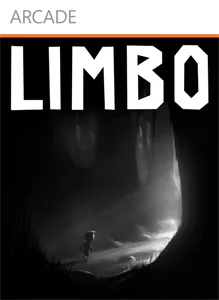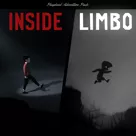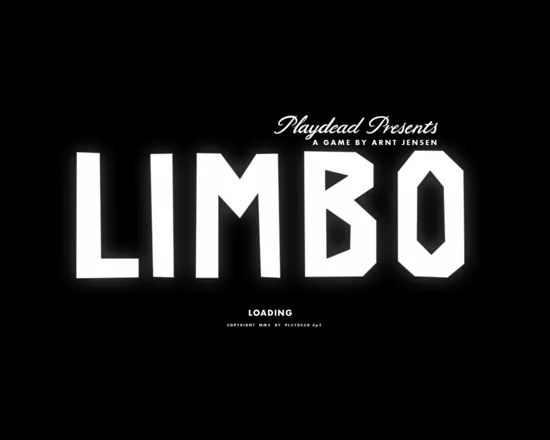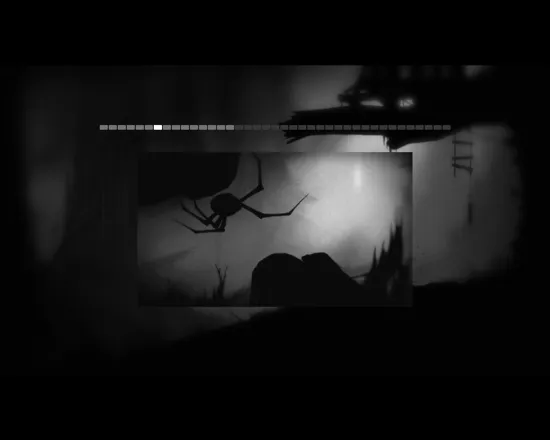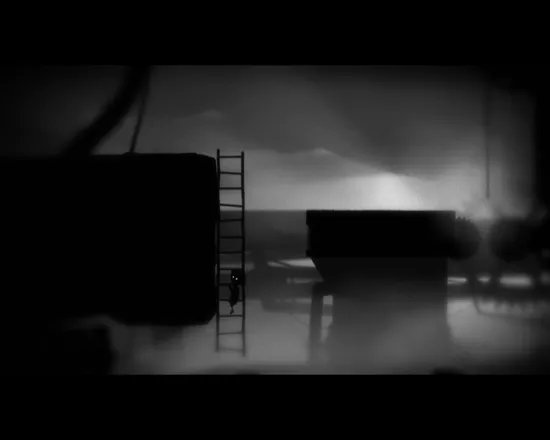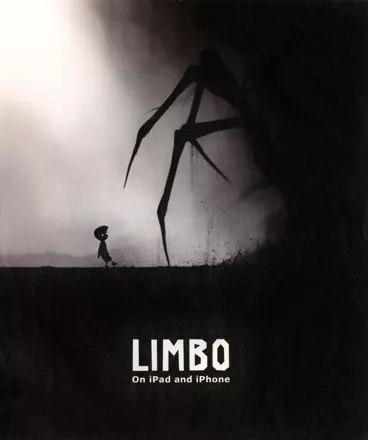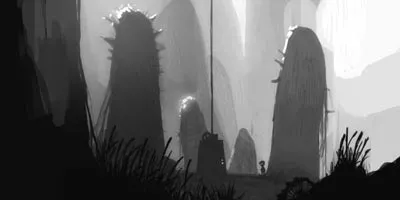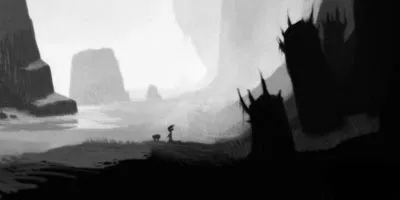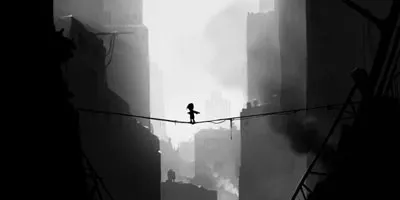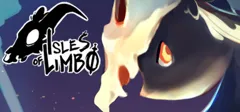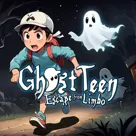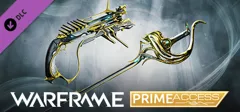Limbo
Description official descriptions
Limbo is a side-scrolling puzzle platformer set in a sinister, monochromatic world. The player controls a protagonist simply known as The Boy, who is said to enter the world Limbo in search of his sister. However, the story as a whole can also be seen as a metaphor for the search for companionship and getting around in a new environment. Not a single clue is given at the start, there are no cut-scenes and the game starts right away. In that world filled with hazards and danger, his means are few and he is extremely vulnerable. Only two buttons are used, a feeble jump and one to perform an action, combined with movement. This allows him to explore the world and hang on ledges, slide down slopes, push objects, pull levers, and cling to ropes, but the player has to make most of what is present in the environment to get by, often with physics-based elements.
The gloomy world has a dusty filter showing the game through misted glass, and no vivid colours are present. It is divided into 24 chapters that seamlessly flow into each other, only from the level selection in the main menu can be derived where a new chapter starts. The world is rendered in 2D but with different layers of depth in the scenery. It moves from a forest to an abandoned city and eventually an industrial zone. The player faces three kinds of challenges. There are obstacles where The Boy simply needs to find a way to progress, there are dangerous creatures that hunt him down and try to kill them, and finally there is a gang of children who band together to ward off the intruder and set up traps for him, with a touch of Lord of the Flies. Encounters with other humans are however brief and rare. These account for most of the horror moments, of the psychological kind, with other unnerving sequences like when the player is forced to use the corpses of other children as a bridge.
Music and sound effects are minimal and there are no on-screen elements referring to health or other statistics. Every single misstep, often with gruesome consequences, is fatal. In the same vein the boy cannot jump from great heights or jump very far. When dead, the game immediately reloads before the current puzzle. Most of the encounters are centered around puzzles and these are sometimes based on timing or speed when being chased. Other elements serve only for setting the scene, when The Boy gets to ride a boat to cross a lake (he cannot swim and drowns immediately) or finds the corpses of the people who did not make it in Limbo. Most of the game elements are discovered through experimentation, like the effects of a glowing worm that attaches itself to The Boy's head, changing the flow of gravity, or what happens when a giant spider captures him. There is only a single path through the levels and generally there is only a single solution to a problem.
Groups +
Screenshots
Promos
Videos
Add Trailer or Gameplay Video +1 point
See any errors or missing info for this game?
You can submit a correction, contribute trivia, add to a game group, add a related site or alternate title.
Credits (Xbox 360 version)
168 People (140 developers, 28 thanks) · View all
| Created and Directed by | |
| Director of Development | |
| Producer | |
| Art | |
| Sound Designer | |
| Composer | |
| Boy Programming | |
| Boy Animation | |
| Lead Game Designer | |
| Lead Level Designer | |
| Design | |
| Scripting | |
| Programmers | |
| [ full credits ] | |
Reviews
Critics
Average score: 89% (based on 88 ratings)
Players
Average score: 3.7 out of 5 (based on 155 ratings with 4 reviews)
The Good
- Excellent visuals and sounds.
-
Gruesome, violent death scenes.
-
The Boy is a lot like me. Wears glasses (or not; can't really tell). Not the athletic type but he is a survivor (he respawns right after each death).
-
Some of the deepest exploration of interpersonal relationships in video gaming. You feel these characters. The vicious guys (bullies) who try to kill the Boy. It's a cold world, not because of the natural hazards, but because of people. Bad, evil, people. The human race is constantly turning against each other and fighting each other. We will be our own demise.
-
The Boy is an unnamed protagonist.
-
Well, I'll keep talking about the Boy. He is the main reason why Limbo is great. He is a black figure with white eyes. Great symbolism throughout. His choice of colors suggests that he lives in a black, evil world, and he is just as black as the world around him, but he believes that good and beauty exist in this world and he wants to see them.
Have you heard the Blind Guardian song "Bright Eyes"? Yeah, this Boy has Bright Eyes.
-
Unlike in Braid, the Boy cannot jump on enemies. The Boy cannot equip weapons or attack in any way. He has to use the environment to defeat enemies. Mostly he has to use the weaponry and hazards that were meant to kill him to kill the enemies.
-
So basically the Boy is one of the (physically) weakest protagonists in gaming history. He is human. (However the Boy does have some unusual strength when he is climbing a rope or grabbing a platform.)
-
Sparse ambient soundtrack. The audio in Limbo is mostly industrial noise. Occasionally there's music playing similar to Stars of the Lid's The Tired Sounds of Stars of the Lid. Every musical piece serves a function.
The Bad
The gameplay. Despite all the good things I have talked about, I didn't like the gameplay.
Since I'm reviewing the Windows version, I'll point out that there's no Gamepad support. There's no option to change the button layout. There is, however, a "Settings.txt" file in the game folder that allows you to use WSAD controls. But in any case the controls are awkward. The Boy doesn't move the way you would expect him to. It's quite obvious that this is intentional on the designer's part, but it's still bad.
The puzzles. Precise timing is often required, so even if you figured out the solution, you could still die easily. After you die you're back to the beginning of the puzzle. Very annoying. The way that the levels are designed, Limbo has become an action game more than anything else, because reflex and dexterity are more important than observing and thinking. It's a puzzle game that tries to emphasize on action or an action game that pretends to be a puzzle game. The result is a frustrating experience that isn't much fun.
The levels are unnamed and unlabeled. This means that when you're stuck in a chapter and need to use a walkthrough, you have no freaking idea which chapter you're currently in. You have to open a walkthrough in your web browser, and search for vague terms like "gravity switch", "pond" and "spider". This is stupid, and quite laughable as well. How hard is it to display a number of the current level?
The Bottom Line
If Limbo were a film, it would have been a four-star film, with rich symbolism and a deep exploration of themes. Limbo isn't a film. Limbo is a game that doesn't provide what games are supposed to provide.
Windows · by Pagen HD (146) · 2014
The Good
If you're a bit like me, you don't see every change pushing you out of your comfort zone as an exciting opportunity to tackle new challenges. Relationships strand, companies cut workforces and accidents happen. You count your loss, adapt, and move on; it's the survival struggle that determines man and gives meaning to life. But starting over can be an unnerving period to become at ease again with the new circumstances.
Despite the Microsoft marketing blurb describing this game as the search of a boy for a girl, Limbo is in fact the metaphor for that process. When the boy awakens and painfully slow picks himself up from the forest floor, he is in a bleak environment, rendered entirely in monochromatic colours with a soft filter on top. The boy shows no emotion. He is standing there, a dark silhouette with no discernible features and two glowing eyes. Try to walk left and you receive the Wrong Way achievement. What did you think? There is no way back. The boy doesn't mind. Resigned, he awaits where you will take him and he won't convey any emotion for the rest of the journey. Limbo is that place between heaven and hell, but you're not sure which one you are heading to.
Not only in visual design is the game an exercise in minimalism. There is no music and sound effects are scarce, with the soft humming of the forest in the background, hungry in anticipation for your next step. The controls are similarly simple: you can walk around, slide down slopes, jump, and use a button to interact with the environment. No on-screen indicators, no cut-scenes, all the fat is cut away to get to the core of the experience. The weakness of the boy is apparent; the jumping height is very low and dropping down from heights is often not an option. Especially the detailed animations convey how feeble your character really is. When knocked back, the boy lies there, dizzy, and it takes some time to compose himself again, crawling back up clumsily. Put the hostile environment in contrast with that: every location oozes with death or desolation, or has prepared a trap for you. When you die for the first time, falling out of a tree with a soft thump, impaled on a set of spikes, ... you decide to care for this boy. He does not shriek and after a fadeout he reappears, to give it another try.
The world where you end up knows no voluntary altruism and despite the simple appearance this certainly is not a game for young children. You don't want to be alone all the time and the game toys with that. When you meet the first other human after half an hour, it turns out to be a discomforting experience that crushes your hope. Similarly the only time you receive help is indirectly, when you use floating corpses to cross a small lake (the boy cannot swim). The boy certainly isn't a match for some large creatures that lurk in the forest and there are some very rewarding scenes where you are captured or have to use all your wit to outsmart them. Soon, not only the forest but some other boys gang up against you. It's like Lord of the Flies - they already know the secrets of the forest but they have no interest in giving you a chance. You want to chase them and explain you mean no harm, but there is no opportunity. You're an intruder all the time. You look for human companionship, but they prepare traps for you and disappear quickly out of view when you arrive. If you look past it as a game, it's a painful experience.
So it's a platformer, but much more about puzzle solving and understanding the mechanics of the environment. Your options are few, but despite that it often takes a lot of trial and error to progress. There is however a steady pace because you don't need to backtrack or experiment with too many possibilities. You can swing from some vines, activate levers and switches, and push around objects to reach higher areas. In later levels you need to thwart gravity and sometimes a worm will attach itself to your head and take control of your mind, forcing you in a single direction. Some of the challenges are very innovative and extremely rewarding to solve.
There is no general story, even though a girl will appear a few times. All of the puzzles have their own background however and most of them make sense as a hurdle to overcome.
The Bad
For all the moody wonder of the first part, the game takes a dive in the later levels set in a factory. Once you're accustomed to the controls the game prepares more elaborate situations for you, including escalators, giant cogs and complex mechanisms of doors and platforms that require impeccable timing. They are smart and make for a great challenge, but they lack the emotional attachment of the first part of the game. There is less focus on exploration, no more characters or creatures appear, and except for the scene where you arrive at an abandoned hotel the environment isn't that imaginative any more.
The focus starts to shift tremendously from exploring to complex puzzle sequences. After a while you forget about the boy and how many times he died, you just keep trying to nail the timing and progress. It's a logical step in difficulty to keep the game challenging, but it largely cuts away its own charm. The entire game can be completed in three hours by an experienced player and what you get out of that is fair for 1,200 Microsoft Points.
The Bottom Line
Especially for the first part, Limbo is a devastating emotional rollercoaster of sad melancholy by some madly talented individuals who know how to make a modern platformer with creative challenges. It is infused implicitly with so much convincing, intelligent charm, and toys with your emotions and insecurities. It resonates deeply. Play it at night, in the dark, and let it sweep you away.
Xbox 360 · by Sciere (935416) · 2010
Still has one of the best boss-fights ever
The Good
- Amazing atmosphere
-
Oozes creativity
-
Clever puzzle-design
-
Often gory or painful deaths
The Bad
- Not very long -
Loses its novelty quite fast
-
stiff controls
-
Not really any sort of music
The Bottom Line
This isn't going to be my new style of reviewing, don't worry about it. It's just that this game is so short that by the time I was done with it, I hadn't even taken any notes yet. Normally I use a style like this to review some of those "special" games like Skyrim and Fallen Sage, but while Limbo is definitely special in many ways, this is merely for the sake of convenience (there is not much to say anyway).
In Limbo you play as a little, unnamed boy and have to traverse a 2D world where everything is in shadows. I am pretty sure that everybody has gotten the message after like two years: "The shadows are just the beginning of what this game has to offer, there is tons of atmosphere" and so forth. Yes, that is most certainly true. The Shadows are sort of a herald of things to come and the designers put in a lot of effort to make sure that Limbo genuinely feels like an experience. The way people act in this world, the sense of oppression all the obstacles give you and the grim look everything all contribute towards making the audience feel like they are in another world, it's quite absorbing to say the least.
As you travel to the right (where else?) you will encounter many traps and hazards, some of which require you to solve some puzzles before you can move on. The puzzles were honestly very well designed and I liked it that you never had to travel far to find everything related to the solution, most of the time everything you needed was within five seconds walking of the contraption blocking your path.
This might give you the idea that Limbo is a very strong title, but sadly I have to say the opposite. While the puzzles remain consistently good throughout the entire experience, the atmosphere kind of loses its way after a while. At the start of the game there are two entities besides your character: a giant spider and some people setting up traps for you, this was the best part because you felt like you were actually interacting with and fighting against other things in the world, like you were actually trying to beat organic opponents.
After beating both these two opponents though you just kind of move on and you just end up solving random puzzles. There doesn't appear to be anybody setting these traps up for you, so it doesn't feel like you are working towards anything anymore. I heard a lot of reviewers say that Alice: Madness Returns was worse than its predecessor because there were no longer any NPC's to make the world feel alive and that's what I feel here as well, Limbo becomes deserted. Some might argue that it fits the theme, but I have to disagree because the beginning of the game sets the story up as a tale of survival against enemies that are either more organized or much larger than you.
After that I grew kind of bored with the game, especially because I suck at puzzles. The game is kind of short, but as much as the art-style and gameplay are filled with creativity, the story progression was clearly not. Limbo set out with the spider as its only idea, but couldn't figure out anything else to fit in it. If you like puzzles a lot, then you will find the ones in Limbo to be of a good quality and enough incentive to keep playing. If you were more interested in the horror theme and were hoping Limbo would fit in that category, then I can only recommend it if you find it on sale... such as the Humble Indie Bundle currently on sale... you should probably buy that one.
Windows · by Asinine (956) · 2012
Discussion
| Subject | By | Date |
|---|---|---|
| Did you know? | click here to win an iPhone9SSSS (2261) | Apr 3, 2015 |
Trivia
1001 Video Games
Limbo appears in the book 1001 Video Games You Must Play Before You Die by General Editor Tony Mott.
Awards
- 4Players
- 2010 – #3 Best Xbox Live Arcade Game of the Year
- GameSpy
- 2010 – Downloadable Game of the Year
- Indie Game Challenge
- 2011 - Achievement in Art Direction
- 2011 - Grand Prize
- PC Games (Germany)
- Issue 01/2012 - #3 Best Game in 2011 (Editors' Choice, together with Anno 2070)
- Issue 01/2012 - #4 Surprise in 2011 (Readers' Choice)
- Issue 01/2012 - #2 Best Indy-Game in 2011 (Readers' Choice)
- Spike Video Game Awards
- 2010 - Best Independent Game
- Xbox 360 Achievements
- 2010 - Arcade Game of the Year
Analytics
Upgrade to MobyPro to view research rankings and price history! (when applicable)
Related Sites +
-
Limbo (Xbox Live Arcade) Walkthrough and Achievement Guide
a full walkthrough and achievement guide for the game, on DIYGamer -
Limbo 2: The Bars Lowered
a humorous take on how Activision would handle a sequel to the game -
TrueAchievements achievement guide
The TrueAchievements achievement guide for Limbo
Identifiers +
Contribute
Are you familiar with this game? Help document and preserve this entry in video game history! If your contribution is approved, you will earn points and be credited as a contributor.
Contributors to this Entry
Game added by Sciere.
Linux added by Hamish Wilson. iPad, iPhone added by GTramp. Nintendo Switch added by Kam1Kaz3NL77. Xbox One added by Kennyannydenny. PS Vita, PlayStation 3, Macintosh, Windows added by Kabushi. Windows Apps added by Koterminus.
Additional contributors: Yearman, Big John WV, Patrick Bregger, Kennyannydenny, joicrawu.
Game added July 21, 2010. Last modified December 13, 2024.


